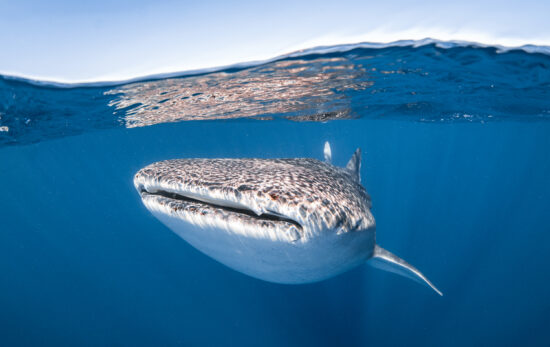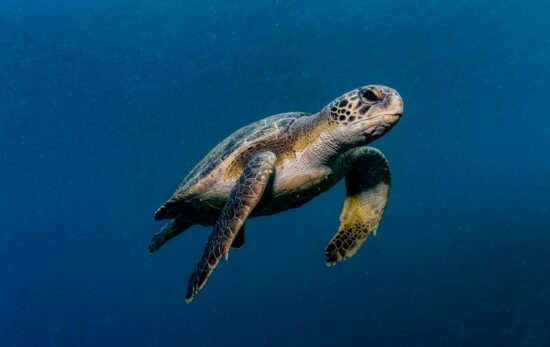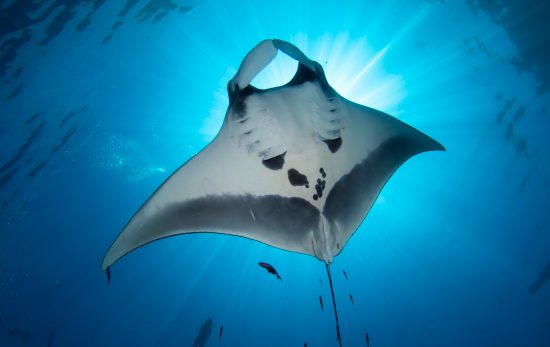Manta rays belong to the elasmobranch group, just like sharks. They have existed for around five million years, and they’re closely related to other rays you can find in the ocean. They have a flattened body, but they no longer live along the bottom of the sea. Instead, they move within the water column as if they are flying, elegantly using their modified, wing-like pectoral fins.
There are two species of manta ray: the resident reef manta ray and the giant oceanic manta ray. Both are plankton feeders. This means instead of teeth, they use their gills to filter the microscopic food from the water. It’s thought that they can live between 40 and 50 years, but we still need more information to be able to establish their exact longevity.
Read on to see how to distinguish between the two species of manta ray, as well as some other interesting manta ray facts.
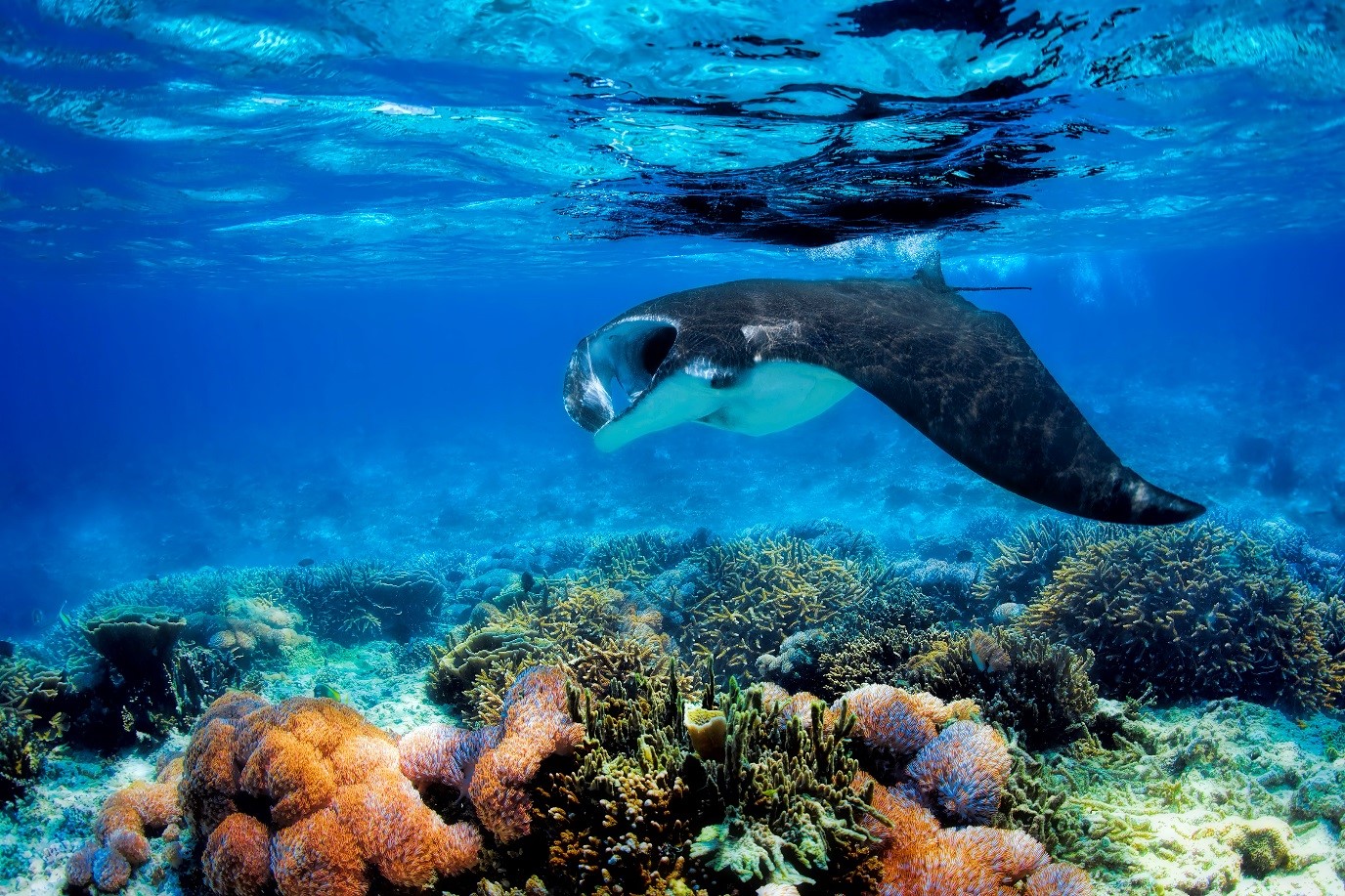
Resident Reef Manta Ray
Mobula alfredi
Of the two species, the reef manta is the smallest, with an average disc width of 10 to 11.5 feet (3-3.5 meters). The exception to this rule is the population of Mozambique, in which they can grow up to 13 to 15 feet (4-4.5 meters) wide. This species weighs around 2,900 pounds (1,300 kilos).
Female manta rays are larger than the males to accommodate their pup during pregnancy. The ventral part of the body is white with black spots, while the dorsal side is darker, forming a distinctive white or grey Y-shape along the ‘shoulders.’
As the name suggests, this species of manta ray usually lives along coral reefs and makes short migrations according to the abundance and availability of food. It is also listed as vulnerable on the IUCN Red List.
The sting that is present in stingrays is absent from all manta rays — so relax. Manta rays are huge but not dangerous.
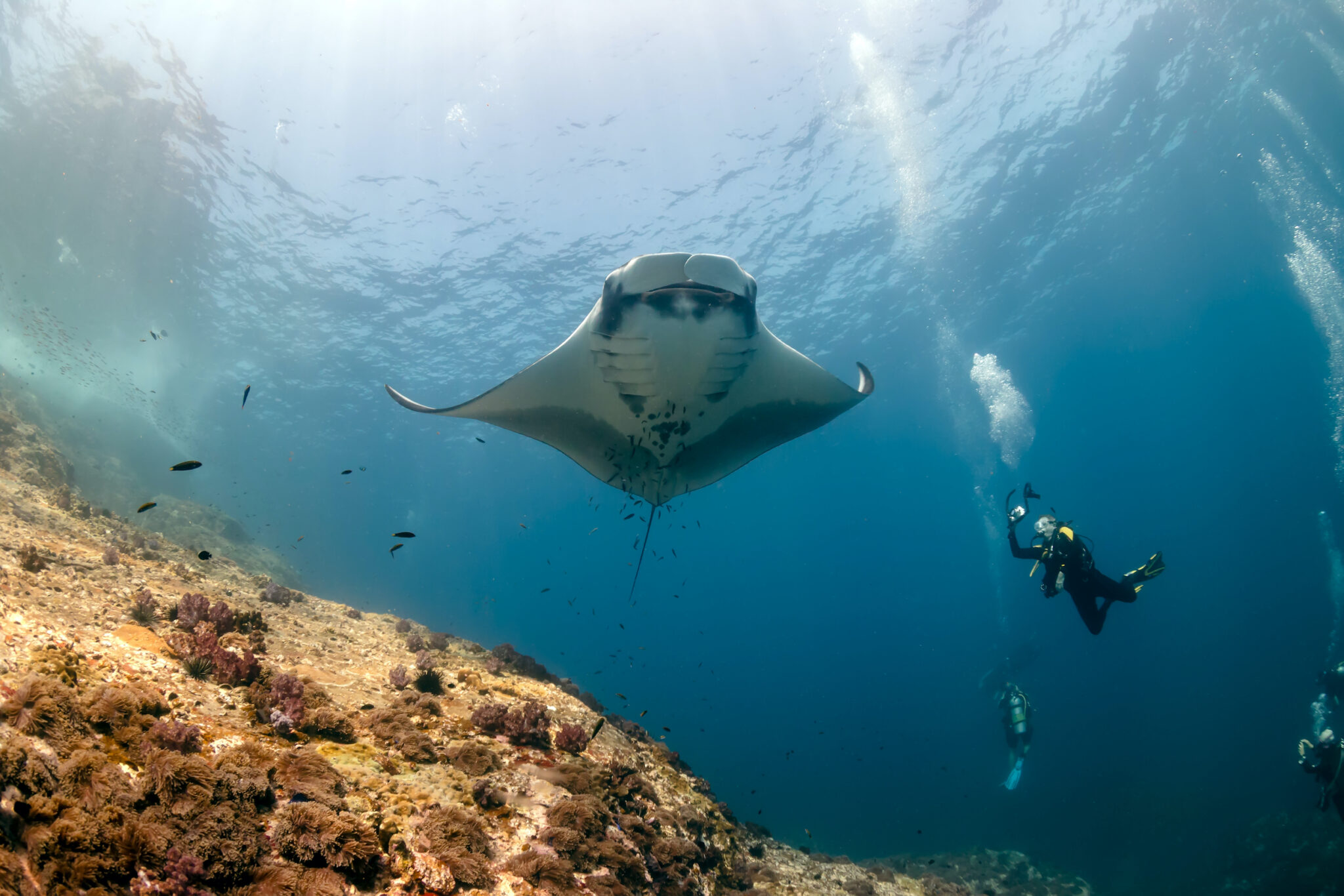
Giant Oceanic Manta Ray
Mobula birostris
This species of manta is the largest ray can reach a considerable size. They reach an average width of 13 to 16.5 feet (4-5 meters) and sometimes up to 23 feet (7 meters). They can weigh up to 4,400 pounds (2,000 kilos)!
Giant manta ray’s ventral part is white with black spots. However, unlike the resident reef manta, the pattern is not present in the area between the gills. Furthermore, the lighter design on the dorsal side is T-shaped.
At the base of the giant manta’s tail is a fist-sized lump of cartilage. It’s an evolutionary remnant of the time they were stingrays (mantas evolved from stingrays). It is non-functional.
Even though they are the largest ray species, these mysterious creatures are actually harder to see than the reef manta because they tend to live in the open ocean and make longer migrations. Consequently, interactions with these giant manta rays are more difficult. The giant manta ray is also listed as endangered on the IUCN Red List.
In addition, it’s worth mentioning that research regarding a third species of manta ray, tentatively referred to as the Atlantic or Caribbean manta, is under way. This possible species shares characteristics with both the oceanic and reef manta rays. Genetic testing will likely confirm or reject this hypothesis in the near future.
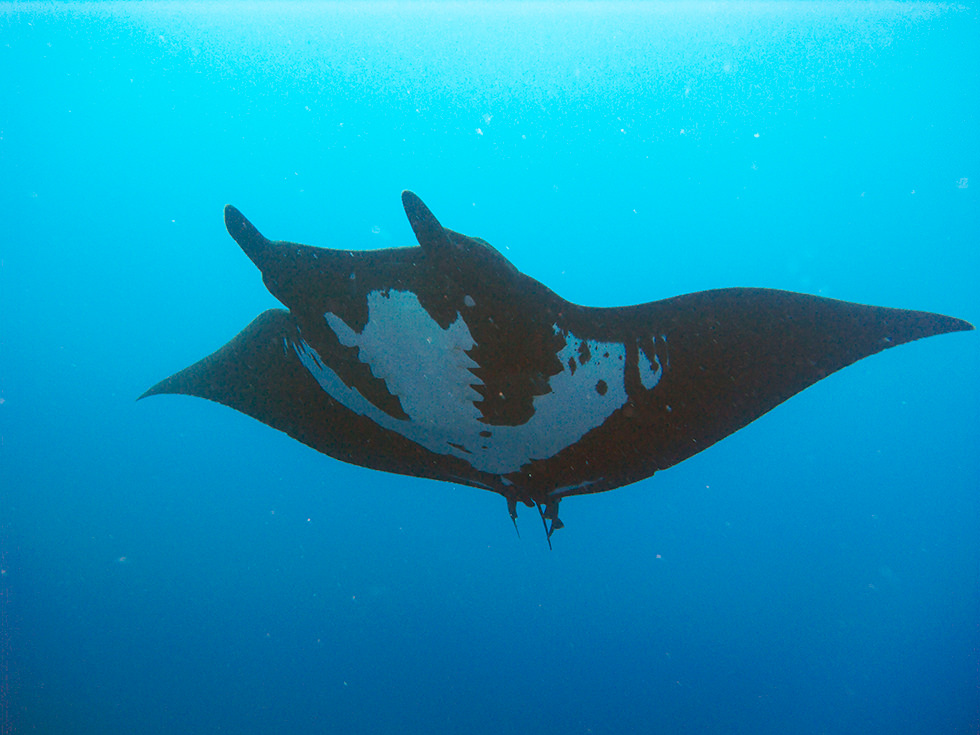
The “Black Morph” Phenomenon
Both species of manta present three color morphs. The first morph is called “chevron.” This is the classic and most commonly encountered manta color pattern. The dorsal part of the body is black with some white parts on the head and on the tips of the lateral fins. The belly is white with some black spots.
The second morph is astonishing. It is called the “black morph.” The mantas presenting this particular morph are completely black dorsally and almost completely black ventrally, with white patches found only near the gill areas.
Reef mantas presenting the black morph seem to be absent in the Maldivian population. On the other hand, this morph is more abundant in the populations close to the remote island of Socorro.
The final color morph is “leucism” or leucitic mantas. These mantas have less pigment than usual, resulting in a body that can look very white. However, these mantas are not albino. This is because they still have some pigment (for example, their eyes aren’t red). They might have some black on the top side of their body, and very faded markings on their bellies. Ultimately, they are much paler than the averagely colored manta.
Manta or Mobula?
There are nine species generally called Mobula. How do we distinguish them from manta rays? First of all, they are usually smaller. These rays have a maximum disc width of 10 feet (3 meters). Mantas and mobulas are both filter feeders, but mobula rays have a bottom jaw which is undercut. This means that when their mouths are closed, the edge of the lower jaw rests much further back than the upper jaw. Manta rays’ jaws are aligned.
The cephalic fins of mobula rays are also slightly different. When rolled up, they resemble horns. In fact, it is this feature that gives them the name devil rays.
The sting is also absent in mobulas, except in the spine-tail devil ray. In this ray, the sting is present but a lot shorter.
Additionally, mobulas tend to travel in large groups. When found, divers usually get to enjoy swimming among hundreds of individuals at one time. However, mobula rays can also be very shy and may only be approachable for a few moments.
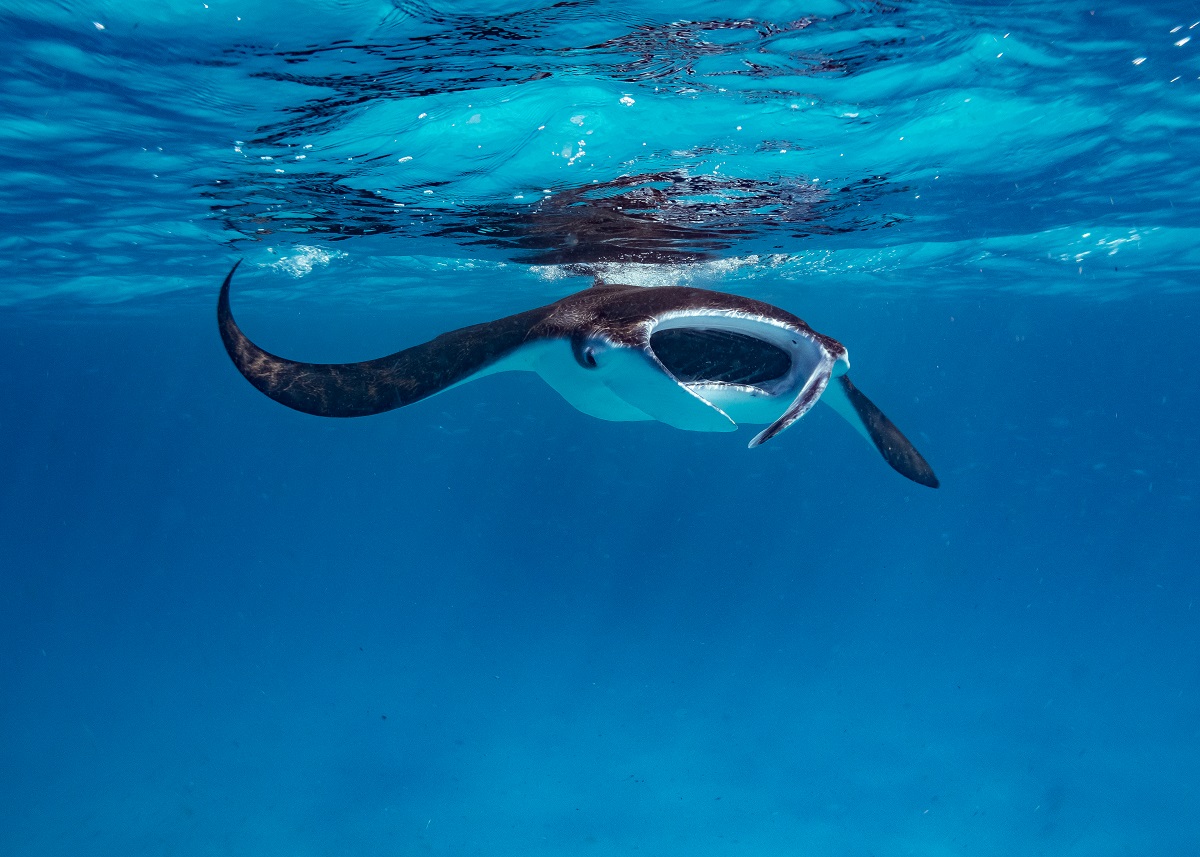
Filter Feeding Machine
Manta rays feed primarily on plankton. Do you know what that is? Plankton is “the aggregate of passively floating, drifting, or somewhat motile organisms occurring in a body of water.” Plankton can be divided it into two groups: phytoplankton, made of microscopic plants and algae, and zooplankton, made mostly of microscopic animals.
Manta rays feed on zooplankton, favouring copepods, arrow worms, mysid shrimps and fish larvae. A resident reef manta ray can eat a daily average of 11 pounds (5 kg) of zooplankton.
Manta rays filter plankton through their modified gills, using their special cephalic fins as a funnel to increase the amount of food entering their mouth. Because they need to eat so much plankton, they have devised some fascinating strategies for feeding on plankton. These are:
Surface Feeding
Manta rays swim with their mouths open at the surface of the water, swallowing large amounts of plankton-filled water. In these cases, it is easy to locate and observe them directly from the boat.
Somersaulting
This is one of the most beautiful spectacles that nature can offer. When there is a dense patch of plankton in the water column, some manta rays will do a backwards somersault in the water, circling around the plankton to maximize their food intake. It is a wonderfully elegant show.
Bottom Feeding
In this strategy, individuals appear to scrape the bottom of the seabed. However, in reality they are hovering just above the seabed where plankton is more concentrated.
Forming Feeding Chains
When many manta rays are feeding in the same area and the concentration of plankton is high, they often form a single file line. In this way, the zooplankton missed by the first manta will be scooped up by the individual behind it. By cooperating with each other, mantas can increase the amount of food eaten.
Cyclone Feeding
An incredible sight — and a rare phenomenon, which can, for example, be seen a few times a year in the Maldives. When concentrations of plankton are extremely high, numerous manta rays create one huge feeding chain. This formation can include up to 200 manta rays. They start swimming in a spiral, creating a vortex. This pulls the plankton into the open mouths of the waiting mantas!
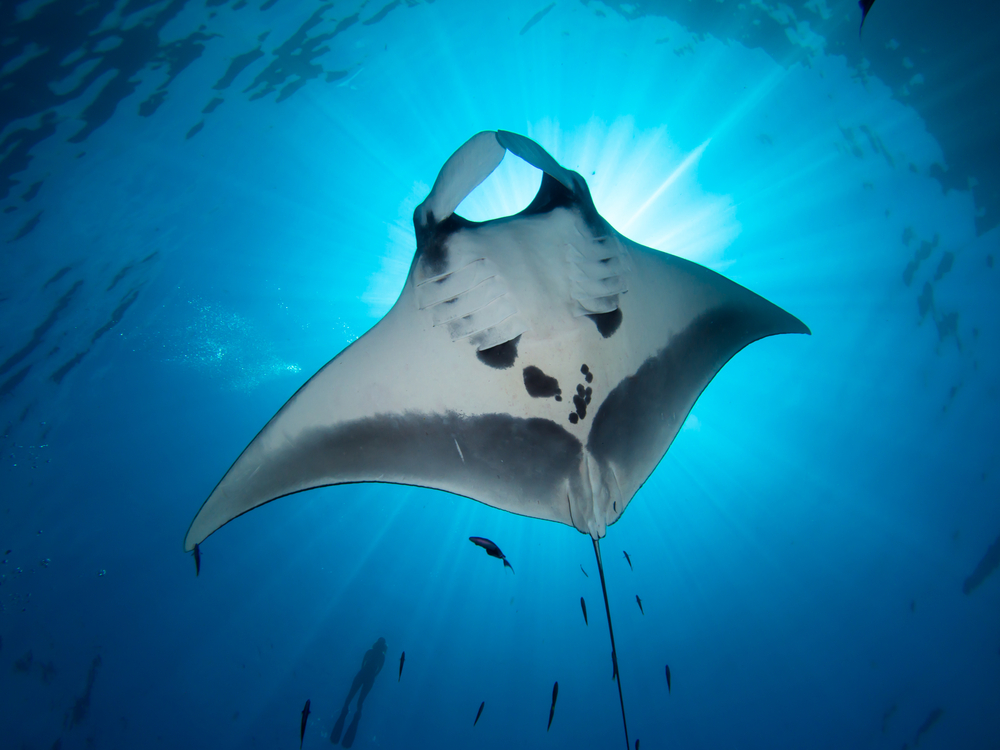
Courtship and Reproduction
Being able to witness the courtship and reproduction of mantas in nature is a rare sight. Courtship usually starts at a cleaning station. When the female comes into estrus, she releases hormones that attract males.
Males usually follow the female for between 20 minutes and 48 hours. In this time, she ‘tests’ the males’ strength and stamina by leading them on a “dance,” looping, swerving, and diving incredibly fast until there is only one male left. This male will then take hold of the female’s left “wing” in his mouth, then move underneath the female so they are facing each other. Finally, copulation begins and takes just a few seconds.
Thanks to the marks left by the bite, it can be established if a female has already mated. After about a year, the female gives birth to one pup (in some rare cases two). The pups are about five feet (1.5 meters) in width, and swim off without any nursing from the females. Unfortunately, it’s estimated that manta rays only breed every 3-5 years, resulting in a serious risk of population declines and eventually extinction.
The number of pups who are born and survive is far lower than the number of manta rays killed by humans.
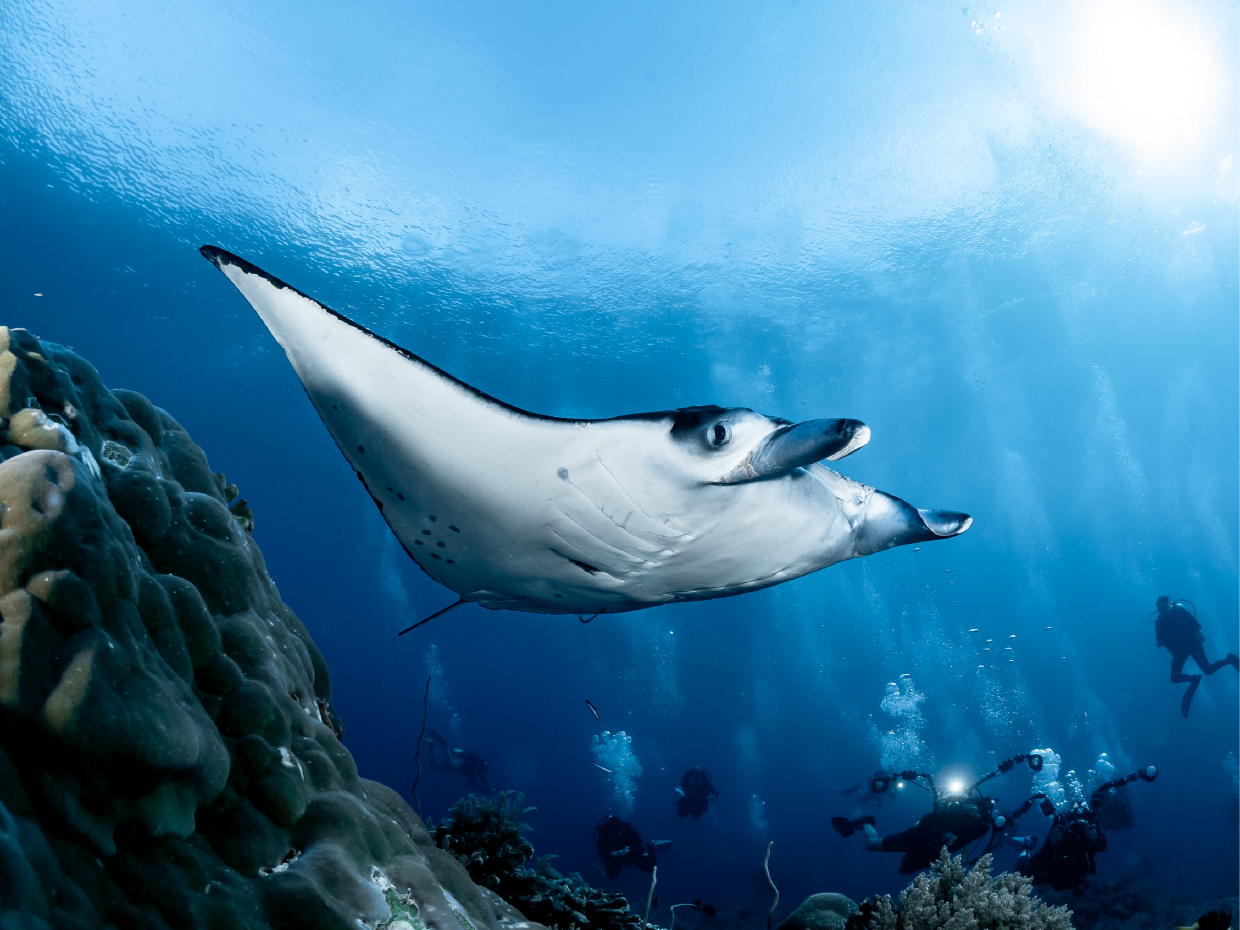
Where to See Manta Rays
Manta rays are widespread throughout the warmer waters of the world’s oceans, including the Atlantic, Pacific and Indo-Pacific regions. These gentle giants regularly visit areas where they can eat in abundance (feeding sites) and where cleaning is available (cleaning stations). Here’s a list of the best places to dive with manta rays.
Feeding Stations
These are areas where, during a certain periods of the year, there is a greater concentration of food. These areas are usually seasonal places because zooplankton concentrations follow currents influenced by weather patterns (e.g. the monsoons in the Maldives).
Cleaning Stations
These stations are comparable to car washes! Manta rays come to these areas to have cleaner wrasse and other fish remove all their dead skin, parasites and food detritus. Female manta rays, on average, spend more time at cleaning stations.
How to Identify a Manta Ray
Each manta is different. How can you distinguish them? Simple, you have to look at the ventral part. The black spots that you see are unique as human fingerprints. The next step is to take a picture and send it to the research centers which will analyze and compare it with the data already included in their huge database and find out if this manta has already been identified. If it’s brand new, you can give it a name! This non-invasive method allows us to study and learn more about these creatures.
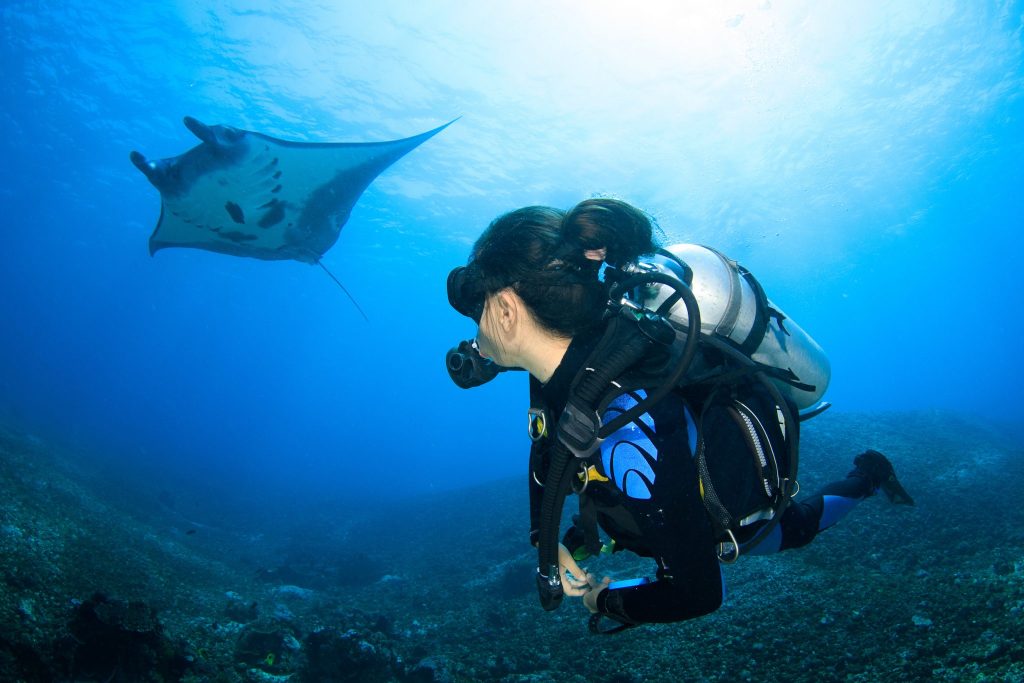
Code of Conduct for Diving With Manta Rays
It is always good to keep in mind that the marine world is not ours. When you are dive or swim with manta rays, we are only their guests. Always choose responsible tour operators who respect the guidelines for interacting with manta rays:
- Approach slowly and avoid noise
- Avoid excess flash photography. Do not point your flash directly into their eyes
- Keep your distance. Try to stay at least 5 feet (3 meters) away from them. If they come close to you, remain calm. Remember, they cannot harm you
- Please look and do not touch. Avoid disturbing them and reduce interaction times
- Always use common sense and maintain respect for these wonderful creatures
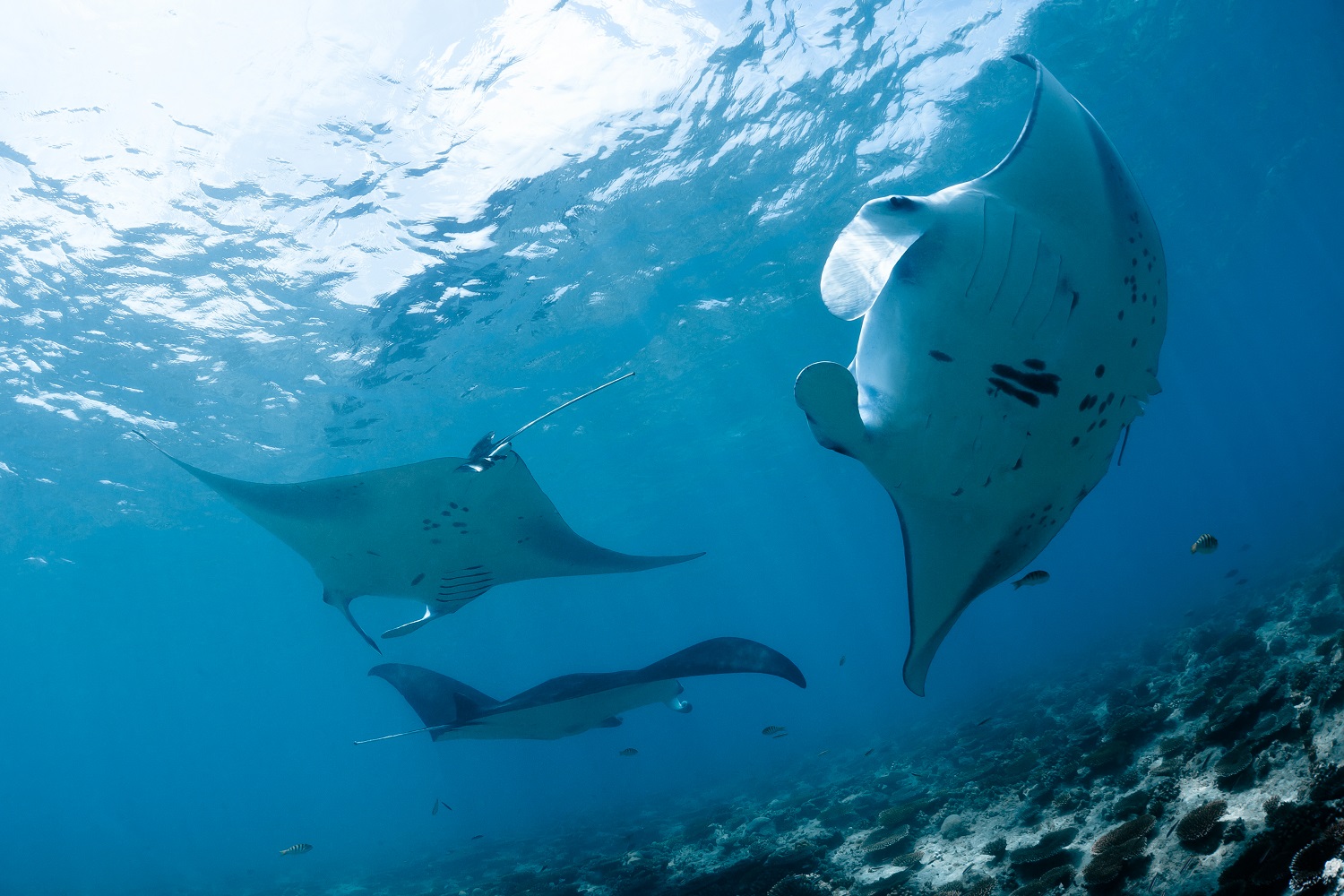
Did You Know…?
Here are some of the most interesting manta rays facts, as well as the answers to some of the most frequently asked questions about these fascinating creatures.
Origin of the Name
The origin of their name is related to a legend. It says that centuries ago Spanish fishermen were frightened by a huge fish whose aspect resembled a large cloak (manta in Spanish). The fisherman feared that if they fell into the sea, the creature would wrap them up and drown them.
Just Keep Swimming
If mantas stop swimming, they will sink! Mantas, like sharks, have a cartilaginous skeleton that is very light, saving them valuable energy. However, they still weigh more than a ton. They can control their buoyancy with the variation of an oily substance located in the liver and by simply swimming.
Another reason for their life in motion is the need to breathe. Swimming creates a current of oxygen-rich water through the gills. They are unable to create this current without moving.
Reproduction is the Driving Force of Existence
Mother Nature gave two penises or claspers to male mantas. What are claspers? And why do they have two? Click here to find out.
You might think that if males have two penises, females have two vaginas. However, this isn’t true. Females have only one vagina called a “cloaca,” an internal ‘room’ where the reproductive, digestive and urinary ducts excrete their products.
Can Mantas Sting?
Mantas have no barbs. Rarely some individuals can show a useless barb on the posterior part of the dorsal fin. They are absolutely harmless. In fact, snorkeling and diving with them creates a close connection. However, it is always important to use good conduct while in the water with mantas.
Brainy Mantas
Anatomical studies have shown that the manta brain is very large. In fact, it has the biggest brain to body ratio among studied fish. It is thought that they have highly developed cognitive abilities and interesting studies are in progress.
Do you remember the whale shark? The size of a whale shark can be ten times the size of a manta, but their brains are only a third of the size of a manta’s brain.
Most divers that have seen mantas note their strange behaviour. It seems that they are curious, and they tend to swim close to observe divers.
Jumping Mobulas
No one knows exactly why mobulas jump out of the water. Researchers think this behavior is a spectacular courtship ritual. Similar to humpback whales, some believe the jumping attracts other individuals or acts as display dominance through the noise produced. Jumping may also be a method for eliminating parasites or escaping predators. Even mantas can do it, but it is much more rare to observe a jumping manta.
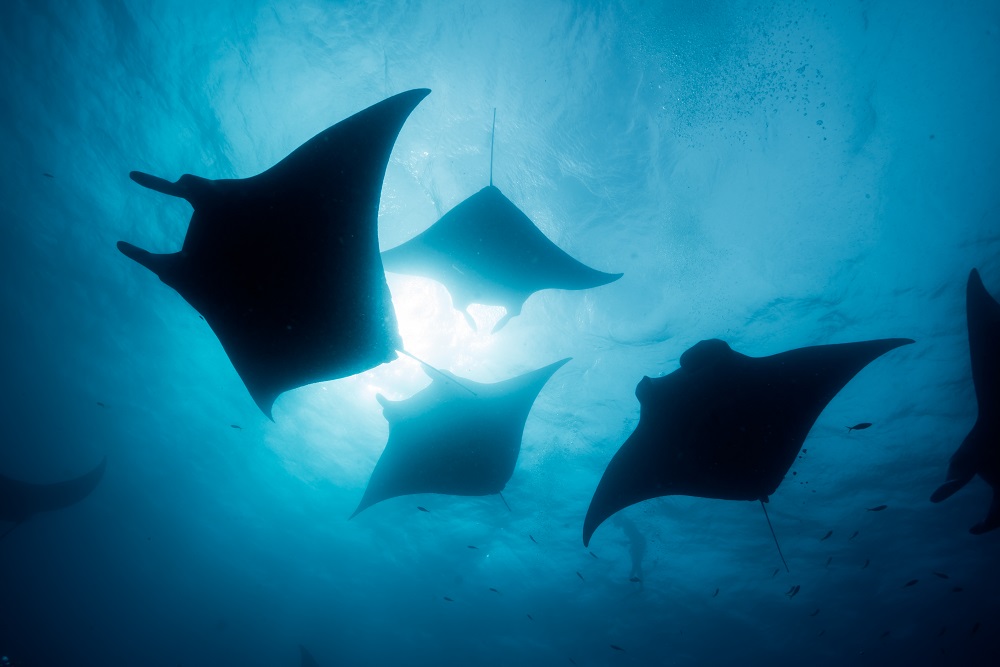
Threats and Solutions
The natural predators of manta rays are some species of sharks, killer whales and false killer whales. Occasionally you may see a manta with the characteristic ‘half-moon’ shark bite on its wing. But the greatest threat to these sea creatures is humans and their activities. Hooks and fishing nets wound and trap mantas, often leading to death (bycatch).
People do not overly seek the flavor and texture of manta ray meat. However, they do seek their gill plates. In Chinese traditional medicine, it is believed that their gills have medicinal properties, such as improving the immune system, preventing cancer and aiding nursing mothers. There is no scientific evidence supporting these uses and recent studies have shown manta rays possess toxic levels of heavy metals harmful to humans (more that 20 times the WHO recommendation of safe arsenic level has been found in manta gill rakers). Many countries, including both Sri Lanka and India, have highly developed manta fishing industries.
How can we stop this? Through awareness campaigns, sustainable fishing strategies, manta conservation projects that work to introduce sustainable alternatives and by avoiding products that use parts of mantas. But above all, you can travel and enjoy manta rays in their natural habitat. This gives commercial value to manta rays. In such a way, it will be more valuable to keep mantas alive rather than to kill them.
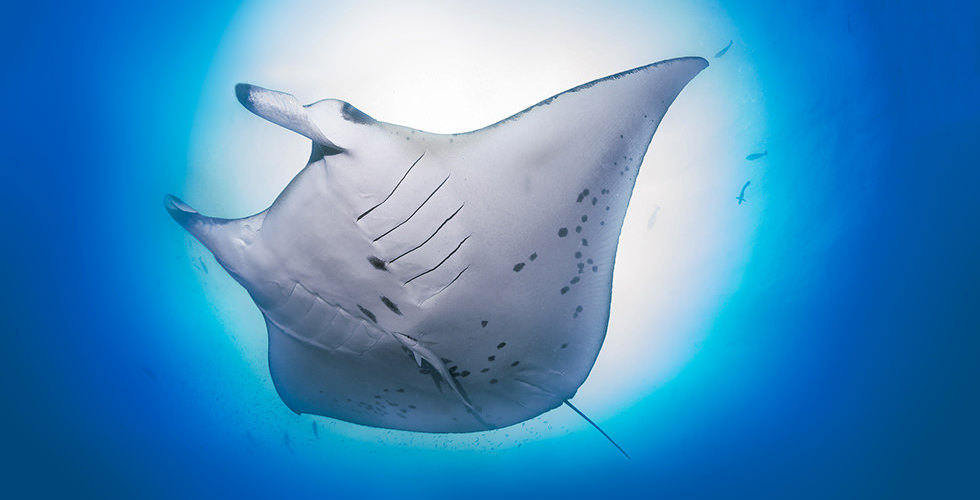
Manta Saviours
In the past few decades, the effort to study and protect mantas has increased. People, driven by their passion for the ocean, have created several associations. They have unified these energies to create networks with the purpose of the conservation of these wonderful creatures.
For further information take a look at Manta Trust, Marine Megafauna Foundation and Project Manta.
Ready to Swim, Snorkel or Dive With Manta Rays?
If you’re feeling inspired to get in the water with these gentle giants, there’s no better time to book the dream dive vacation of your dreams. From the Great Barrier Reef to Komodo, Indonesia, check out the best places to dive with manta rays for some destination inspiration. Then click below to book your trip or contact the experts at PADI Travel for trip-booking assistance.
Credits
This article was written by Mario Passoni and Luca Saponari – two marine biologists involved in several projects concerning ocean conservation and education. Special thanks to Niv Froman, Tam Sawers, Sarah Lewis and Nicola Bassett from Manta Trust, Asia Armstrong from Project Manta and Anna Flam from the Marine Megafauna Foundation.

